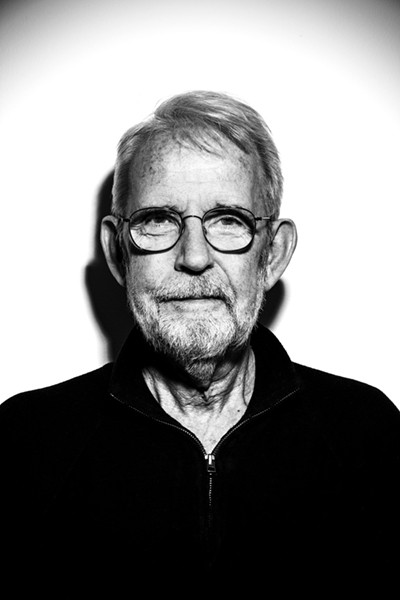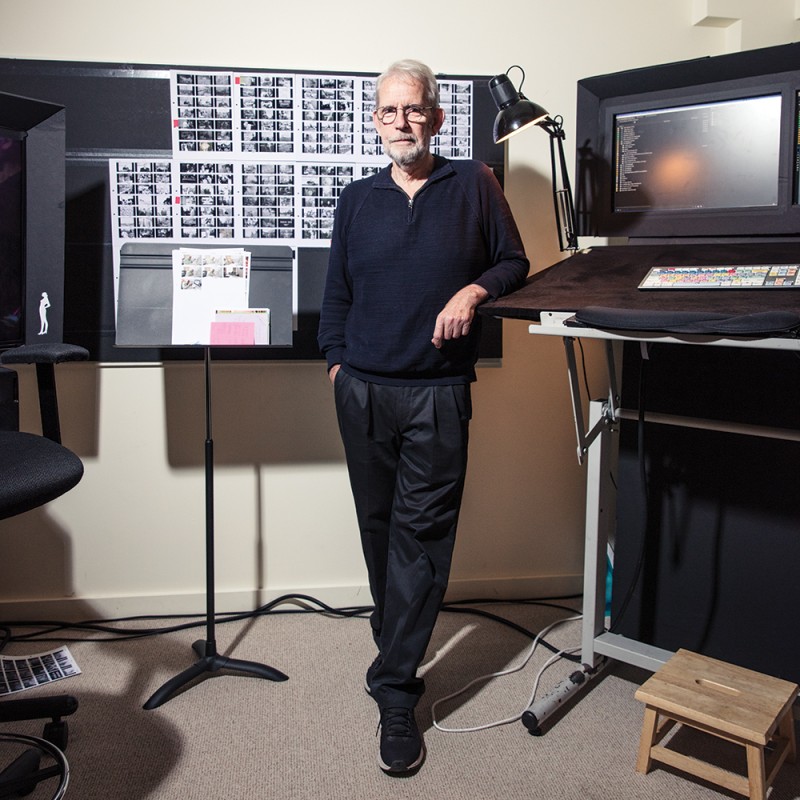Twenty-three years ago, Walter Murch, A&S '65, became fascinated by the 17th-century astronomer Johannes Kepler through reading The Sleepwalkers, Arthur Koestler's 1959 history of Western cosmology. Among Koestler's endnotes, Murch found a reference to a long-forgotten idea about the orbits of the planets in the solar system. The idea was first propounded in 1766 by Johann Dietz, a German professor of physics who would later Latinize his surname to Titius after earning his doctorate. (This was customary at the time—Copernicus began life as Mikolaj Kopernik.) Dietz/Titius noted that were you to take a series of numbers—0, 1, 2, 4, 8, 16, and 32—multiply each by three, then add four, then divide by 10, you would end up with a new series that aligned to a striking degree with the relative distances of the known planets from the sun.
The idea might never have circulated beyond Wittenberg University without a second German academic, Johann Elert Bode, head of the Berlin Observatory, who took it up six years later. Bode had a knack for publicity, and after simplifying the equation, he began talking it up. Titius-Bode, as the idea is now known, seemed to predict the orbits of Mercury, Venus, Earth, Mars, Jupiter, and Saturn. When musician-turned-astronomer William Herschel discovered Uranus in 1781, its orbit fit the progression, too. There was a troublesome gap between Jupiter and Saturn, where the equation said there should be another planet, but then in 1801 an Italian priest named Giuseppe Piazzi discovered Ceres, an asteroid so large it is now classified as a dwarf planet, orbiting pretty much where the equations predicted. Things looked good for Titius-Bode.

Image caption: Walter Murch
Image credit: Chris Gloag
But in the ensuing years, critics have been rough on the idea. Mathematician Carl Friedrich Gauss hammered it for having too many arbitrary elements, too small a sample size, and no explanation for why the physical reality would line up with a mathematical projection. When Neptune was discovered in 1846, its orbit was way off the Titius-Bode progression. Contemporary scientists who have even heard of it usually dismiss the whole thing as meaningless coincidence at best, or as numerology, which puts it in the same back room with astrology.
None of which has deterred Walter Murch. For more than two decades he has thought about Titius-Bode, tweaked the math, and looked for ways to make a stronger case. In a series of periodically updated slide shows that he presents to audiences from time to time, he has noted some deeper correspondences and observed that Titius-Bode also predicts the orbits of the major Jovian moons, of moons orbiting Saturn, Uranus, and Neptune, and of a recently discovered exoplanet system called Trappist-1. He has pointed out that if one overlays the progression of planetary orbits with the corresponding intervals of Western musical theory, the solar system forms a major chord, a seventh, to be precise. He argues that if you think about T-B in terms of three-dimensional waveforms instead of two-dimensional geometry—Murch is an expert acoustician who knows a great deal about waveforms—it makes more sense. Murch has worked on the Titius-Bode for 20 years, which is one more indication of what happens when he seizes on an idea: he takes it out for test drives to see where else it might go.
In his response to a fact-checking email, Murch wrote, "This version of Titius-Bode is correct, as far as it goes. The planets and moons of the solar system are in this relationship with each other, and that relationship is musically coherent." But he concedes that there's no good explanation for why planetary systems would physically align this way. At least, not yet. But he believes T-B still merits a serious look by astrophysicists. If that happens, he will eagerly pore over their conclusions. If not, that's OK, too, because he's had a blast digging into it for all these years, and anyway, there's something else that has his attention now, something interesting going on with this 3,200-year-old Sumerian clay tablet ...
Lawrence Weschler has written 16 books, the most recent being Waves Passing in the Night: Walter Murch in the Land of the Astrophysicists (Bloomsbury, 2017). He doesn't remember how he met Murch, beyond recalling that "we started running into each other 15 or 20 years ago. We're the kind of people who would find out about each other. We're both omnivorously polymathic." For the last dozen years or so, Murch has been showing him iterations of his Titius-Bode slide show and discussing other of his ideas. There's the one about the mathematics of the Egyptian pyramids, and the one about how a more apt and useful metaphor for economic "bubbles"—the dot-com bubble, the housing bubble—would be "tumor," considering what they do to an economy. There's the one about the Babylonians understanding trigonometry a thousand years before its "invention" by Hipparchus. "Walter just knows stuff," Weschler says.
"I do fall down these rabbit holes," Murch admits. He's on the phone from London, where he's editing Coup 53, Taghi Amirani's forthcoming documentary about the 1953 CIA-backed overthrow of the elected government of Iran. "I remember at school, I was probably about 13, learning about the five-color map problem, and I decided I was going to draw a map that would need five colors." If he succeeded, he would prove that to guarantee that a map has no adjacent areas the same color, one needs a palette of at least five hues. "I spent a couple of weeks after school drawing ever more fiendish maps to try to solve that problem. Eventually I went on to something else." (You actually only need four, which is one reason the adolescent Murch couldn't devise a map that required five.)

Image credit: Chris Gloag
"The biggest rabbit hole I fell down, which I'm still in, was a love of tape recording sounds and then taking those recorded sounds and manipulating them and creating an alternate universe." In the early 1950s, the father of a friend owned one of the first consumer tape recorders on the market, a Revere. When he was around 10 years old, Murch says, "I latched on to it. Every time I went over to that kid's house, it was 'let's play with the tape recorder.' About a year later, my parents recognized this passion and wanted to see more of me rather than me going off to this other kid's apartment, so the family got a tape recorder for Christmas." Murch amused himself hour after hour by recording all sorts of sounds and then cutting and splicing tape to create new soundscapes.
"Even from the age of 3 or 4 I loved to imitate the sounds of things," he says. "If I didn't know a word, I would just imitate the sound of the thing I was trying to talk about, a cat or a rooster or a whistling tea kettle or something. My friends found this very amusing. There was a cartoon character at the time called Gerald McBoing-Boing [who spoke through sound effects instead of words] and they would call me Walter McBoing-Boing and get me to make funny sounds. When the tape recorder came along, I could not only make the sounds, I could make them permanent. It was a new world." And so, a sound designer was born.
Matthew Robbins, A&S '65, met Murch on a freshman orientation campus walking tour in 1961: "He was a lot taller than I am. And he had an FM radio voice. Still does, actually. We basically started talking and never stopped, what can I tell you?" They became best friends, roommates in their sophomore year. Eventually, both married English women and each was best man at the other's wedding. Even their parents became friends. Another incoming freshman, Andrew Feenberg, A&S '65, became a lifelong friend as well. He recalls Murch: "He was rather silent, almost imposing. It was difficult to know what he was thinking. I was slightly intimidated by his size and silence."
Murch's original intent was to become an oceanographer. For a Hopkins undergraduate, that meant first studying either biology or geology, and he chose the latter because he'd studied biology in high school and wanted something new. "I discovered that the fit between me and geology wasn't a tight one," he recalls. "In retrospect, I think it was because in 1961 the idea of continental drift had not been accepted. So, without knowing it, I think I was reacting to the fact that there wasn't a compelling 'story' there. I think if I'd gone to Hopkins maybe four or five years later, which is when [science] admitted continental drift is a real thing, I would have become an oceanographer." The narrative of the once-spurned theory of moving landmasses becoming accepted science resonates with Murch.
A Conversation. With Walter Murch from Nicc on Vimeo.
After their sophomore year, he, Robbins, and Feenberg convinced Johns Hopkins to allow them to spend a year in Europe. Murch and Robbins began with a summer studying Italian at the University of Perugia. Then they bought a used Ducati motorcycle and set off for the Sorbonne in Paris. The Ducati broke down in Vevey, Switzerland, on Lake Geneva, and Robbins went on to France by train while Murch camped out for two and a half weeks, awaiting delivery of a new piston rod. "We actually had several motorcycles while we were in Paris," Robbins remembers. "I mean, we were 19. Motorcycles and black leather jackets. Walter had a gold earring, which in those days got some attention."
"When we arrived in Paris, we found ourselves in a culture that was mad for movies," Robbins says. It didn't take them long to stumble on the Cine?mathe?que franc?aise, where for about a dollar they could see three movies in an afternoon; after a quick dinner, they'd go back and see three more in the evening. They had arrived in France at the height of the French New Wave. Taken by the films of Franc?ois Truffaut, Jean-Luc Godard, E?ric Rohmer, and others, they returned to Baltimore burning to learn everything about film. "We really got hooked on that. We weren't aware that this was a life-changing thing, at least I wasn't, but it was very exciting."
They returned to Johns Hopkins for their senior years and persuaded legendary humanities Professor Richard Macksey to create a seminar on film for them and a few other undergraduates. "We met a couple of times a week in his office," Robbins recalls. "There were only about six or seven of us. We published this journal on a mimeograph machine. I drew the covers." After graduating in 1965, Murch and Robbins enrolled in film school at the University of Southern California. (Another friend and Hopkins classmate, Caleb Deschanel, A&S '66, followed them to the West Coast and became a highly regarded cinematographer.) Murch got himself there on a BMW R50 motorcycle, his new bride, Muriel Ann, known to everyone as Aggie, perched on the back. As with their sojourn in Paris, the Murch gang's timing was good. "The old Hollywood was running its last lap. The door for young filmmakers was just starting to creak open," Robbins says. After USC, Murch moved to San Francisco and joined a cadre of young, ambitious, budding cineastes that included George Lucas and Francis Ford Coppola. He co-wrote with Lucas a dystopian science fiction movie, THX 1138, did the post-production sound for Coppola's The Rain People, and embarked on a career in film.
Even a partial list of Murch's film credits is impressive. He has worked on American Graffiti, all three Godfather pictures, The Conversation, Apocalypse Now (winning an Academy Award for sound design), Ghost, The English Patient (Academy Awards for sound design and film editing), and Cold Mountain. Today, at age 74, he's still at it.
When Murch talks about film editing, his rigorous, analytical mind is on display again, as are the depth and breadth of his knowledge and how he thinks in meta-concepts. In 2004, for example, he granted an interview to an Indian film student named Kiran Ganti. The conversation was solely about the nature of transitions in films; printed out from the FilmSound.org website, it runs to nine dense, single-spaced pages. Here is an excerpt:
"[If] you only studied water, H2O, in liquid form, your understanding would be limited. But if you studied H2O in its three forms, solid ice, liquid water, and gaseous steam, and compared them, your understanding of H2O increases exponentially. Ice, for instance, is the only substance whose solid form floats on its liquid form. No one would have predicted something like that from studying only liquid water. And we learn most about different states of matter at the point that they are changing, transitioning from one to another: from water to ice, for example. In chemistry these are called phase transitions. ... So in a sense, you can look at transitions in a film as moments when the story turns from liquid into a solid, then into a gas and then back to liquid again. As we make transitions from scene to scene, the transitions themselves are provoking us to question what we just saw and what we are about to see. We make unanticipated discoveries. It makes us more alive to elements of the story and characters than we might otherwise be."
The Murch Mind on display: the importance of transitions in film expressed through a story about the various states of water, with a curious scientific fact tossed in for free. "One of the reasons Walter's so interesting is he has such a command of metaphor," Robbins says. "He has a way of taking very abstract concepts and bringing them down to very concrete, everyday examples." Feenberg says, "Most of us just pass by things that are a little bit puzzling or curious. He focuses on them, and eventually they become stories. He has this huge repertoire."
Murch has another theory, this one about the blinking of eyes, which he applies when he edits film. From extensive reading in the psychological literature, he knows that people blink when their brain shifts to a new idea. He has noticed, he says, that great actors seem to know this and take care to blink not when their thinking shifts but when the character's thinking shifts. When he edits, he sometimes seems to time a cut to the blinking of the actor's eyes, as if the character has cued the next phase of the story. "I do not use the blink itself as a cut point," he says, "but to sensitize myself to the internal (largely subconscious) mental rhythms of the actors."
Says Robbins, "It's very Walter Murch to have pounced upon the blink."
Lawrence Weschler maintains files on people and things that interest him, tracking them until he decides it's time to write about them. He's had a Murch file for years, with clippings and notes from their several conversations. Waves Passing in the Night is a combination profile of Murch, exploration of how he thinks and works, explication of Titius-Bode and Murch's re-examination of it, and narrative of what happened when Weschler tried to interest academic astrophysicists in having a look at what Murch was saying about T-B.
Weschler went to work on the book about two and a half years ago after scientists at the Australian National University, Charles Lineweaver and Tim Bovaird, published a paper that said 86 percent of the exoplanets found so far in systems of four or more planets fit orbits predicted by Titius-Bode. The paper has generated a critical paper in response, and a counter-response from Lineweaver and Bovaird; the matter is nowhere near settled, but Murch was buoyed by the mere appearance of Titius-Bode in the title of a peer-reviewed paper after so many years of disregard.
He has worked to refine the theory; it's the sort of thing he does to relax after a long day editing sound or film. He's tweaked the formula's basic unit of measurement, which streamlined it. He has noted that the formula suggests the progression of planetary orbits as, metaphorically, a system of waves, a set of peaks and troughs with the most likely orbits for planets neatly aligning with the midpoints between peaks of standing waves. What's more, he's observed that his slimmed-down formula contains Pythagoras' original definition of the musical octave.
In response to scientists who say he's just playing with numbers, Murch once wrote to Weschler, "What can I say? They're right, I am having a good time with numbers, but number play is an important part of human intellectual effort. The question is: Does the number play link to physical realities? And it seems to me that there is something going on with Bode that at the very least warrants further investigation."
In his book, Weschler goes down a bit of his own rabbit hole, diving into the sociology of modern academic science and a critique of the hegemony of scientists employed by research universities. He tells the story of Alfred Wegener, a German meteorologist and polar explorer who in 1912 (some argue for 1915) first proposed the theory of continental drift. Geologists of the day dismissed Wegener—not entirely without reason, as no one yet understood plate tectonics, which explains how something so massive as a continent could drift—but in the 1960s scientists determined that yes, indeed, the continents move around. Wegener, another omnivorous polymath, had been onto something after all.
"I'm fascinated by who gets to say, and who gets to say who gets to say," Weschler says. "I certainly don't believe that we, as contingent beings in the midst of history, can ever attain a God's-eye objective truth. Science is not a collection of facts. It's a pursuit, a glorious and ever-ongoing activity. As Richard Feynman said, it's about doubting experts. The fact of the matter is that I am deeply aware, every time I read anything scientific, it seems that in 10 years it's either getting disproven or refined. The final status of any claim is not something that can be judged exclusively from within science—it has to do with the philosophy of science. Scientists imagine that they are the final arbiters. If you're serious [as I am] about the notion that science is but one of the humanities, there are other arbiters, also. Nobody has the hegemony. My suspicion on the absolutely peremptory status of experts is rather profound. It doesn't mean I don't have enormous respect. I have incredible respect for science, but I don't think it can exhaust its subjects, ever."
In May, science writer Kenneth Chang wrote in The New York Times about the possible resolution of a conundrum with the newly discovered exoplanet system Trappist-1. The orbits of the system's planets are so tightly packed, they should not be stable; the system should have flown apart long ago owing to extreme gravitational forces. But a team of researchers in Canada, England, and elsewhere discovered that the orbits of all seven known Trappist-1 exoplanets align in a sort of synchrony that resembles musical resonance; furthermore, they ran supercomputer simulations that demonstrated how as the planets condensed out of a disk of gas, they could have tuned their orbits to each other to achieve a stable synchrony, like orchestra musicians tuning to each other before a concert.
That is, the scientists said, Trappist-1 is a planetary system that seems tuned to a set of harmonic intervals. This did not escape the attention of Murch, who also noted, "It turns out that the Trappist planet system adheres to the Locrian mode, one of the seven modes of ancient Greek music."
Weschler sometimes talks about how Murch used to carry around a cloth sack filled with slips of paper. He'd extend the pouch and urge you to take out one of the slips. Each one carried a snippet of text, something Murch thought you'd find interesting or provocative: "Translate the invisible wind by the water it sculpts in passing—Robert Bresson." "If at first the idea is not absurd, then there is no hope for it—Albert Einstein." Receive email from Murch and you will discover that to each note, he appends not an email signature but an image or curious fact. In my correspondence with him, he has sent a photo of a 4,650-year-old pyramid at Meidum, Egypt; a portrait of Vasili Arkhipov with the story of how, as a Soviet submarine officer in 1962, Arkhipov vetoed the impending launch of a nuclear torpedo at a U.S. aircraft carrier during the Cuban missile crisis; a diagram he devised to show the atomic particles of the standard model of physics; and a microphotograph identified only as "cross-section of Gustav Klimt's neurons." All byproducts of time spent in various rabbit holes.

Image caption: Plimpton 322, a 3,200-year-old piece of clay with cuneiform mathematics on it that has captured the imagination of Walter Murch
Image credit: Wikimedia Commons
"Right now, I'm obsessed with the object called Plimpton 322, which is a piece of clay with cuneiform mathematics on it that seems to indicate that 3,200 years ago, the Babylonian Sumerians knew about the Pythagorean theorem and had a kind of trigonometry," he says. (Pythagoras, again. With Murch, things have a way of coming back around for new convergences, as you will see.) "I've been riding that particular hobbyhorse for the last couple of months. I wrote a paper on the Pythagorean theorem for a course in high school and probably ran across [Plimpton 322] then. It was in the news again two or three months ago for some research that some mathematicians have done in Australia. There's a real tug-of-war between people who believe that it is a trigonometric table and people who think that it isn't. So, I was trying to determine for myself what it was." He has been using mathematics software to work out what might have been the Sumerian math. "It's written in sexagesimal mathematics, which is how the Sumerians worked, base 60 rather than base 10, so you have to convert the numbers. Once I did that, it all seemed pretty clear to me. I finally came down on the side of yes, it is definitely a trigonometric table. It has what we'd call tangents and secants and that kind of stuff."
The tablet, he says, looks to be an exercise book that would be given to a student. It has four columns and 15 rows. One column is the number of each row, one the length of the hypotenuse of the triangle, one the length of the "short" leg of the triangle. "And the last column is the square of the tangent of the angle shared by the hypotenuse and the short leg, and this would permit a smart student to derive the length of the missing long leg of the triangle," Murch says. "It's just a remarkable thing to think that 3,200 years ago, people were dealing with pretty sophisticated mathematics. Then it all seemed to disappear. There was something called the Bronze Age collapse around 1200 B.C. that decimated the civilizations of the Near East, and a lot of that information was lost and had to be recovered later. It was kind of like our Dark Ages in Europe."
He is patient while he waits to see whether anyone in astrophysics takes up his ideas about Titius-Bode. "These things take time," he says. "I'm perfectly happy in my rabbit hole. I have a day job making movies. I don't watch television, so I have to do something in the evening. My wife knits, and I sit here doing pyramid stuff or Plimpton 322 stuff. She shows me her knitting and I show her my diagrams and we each say, 'That's nice, dear.'"
Posted in Science+Technology, Politics+Society
Tagged film, outer space, earth and planetary science








